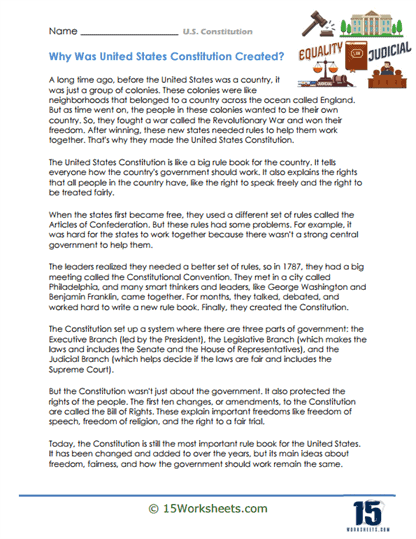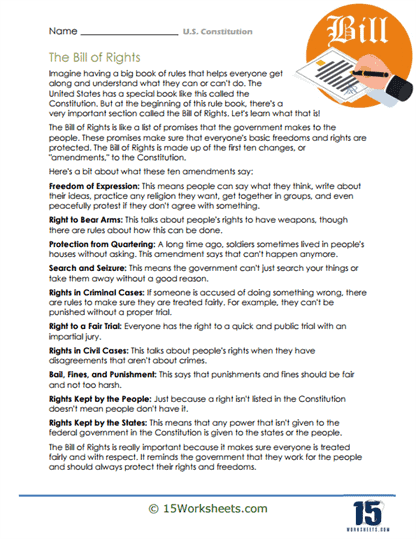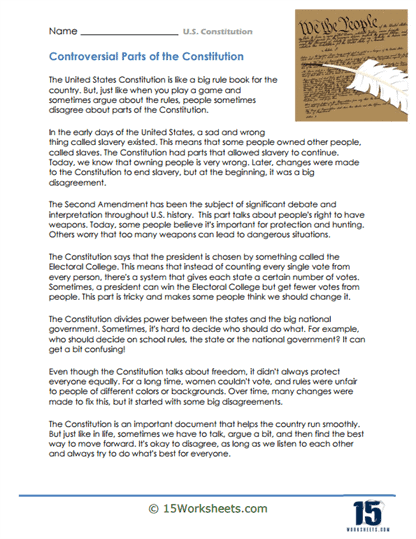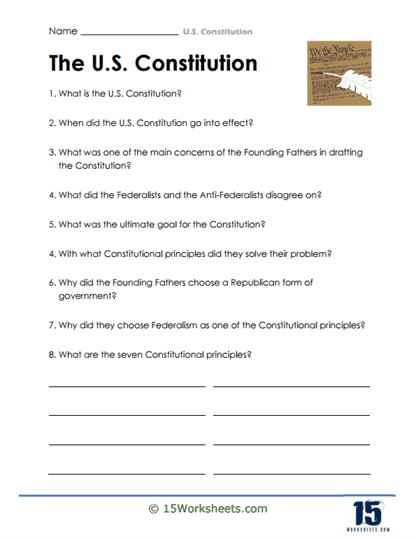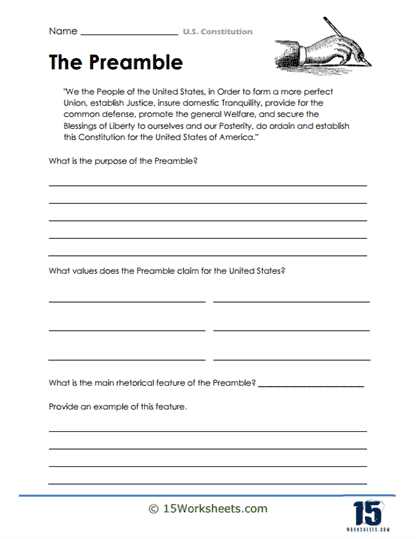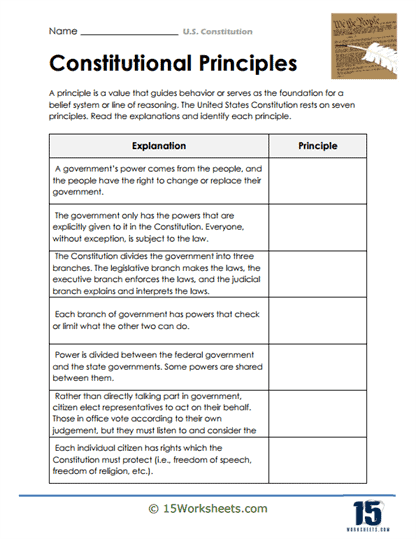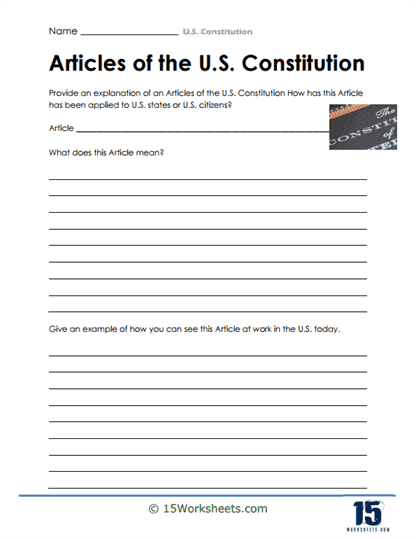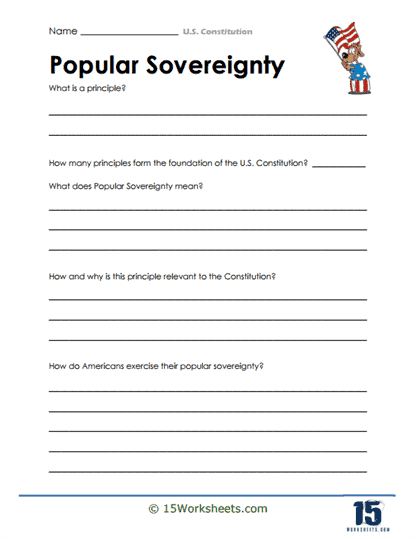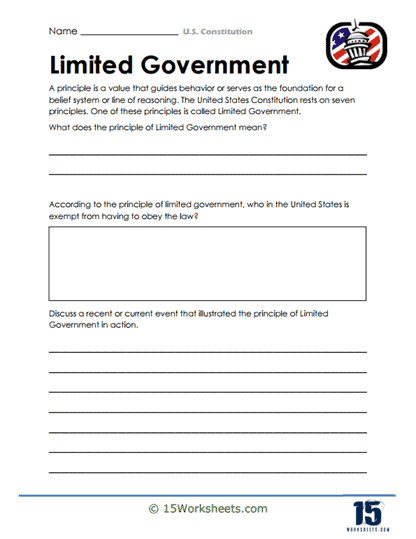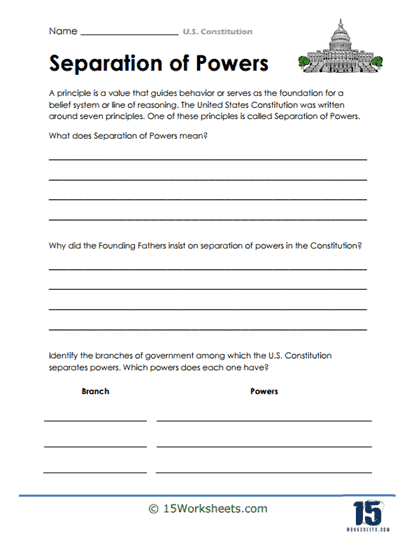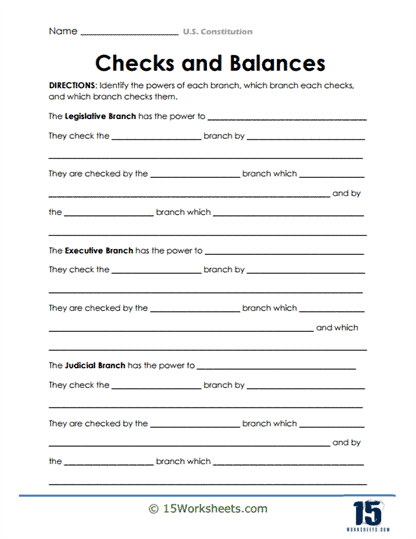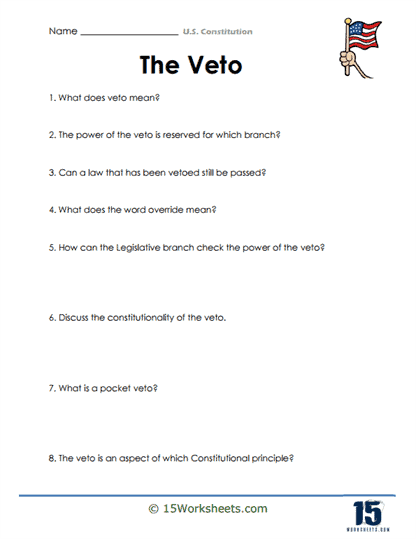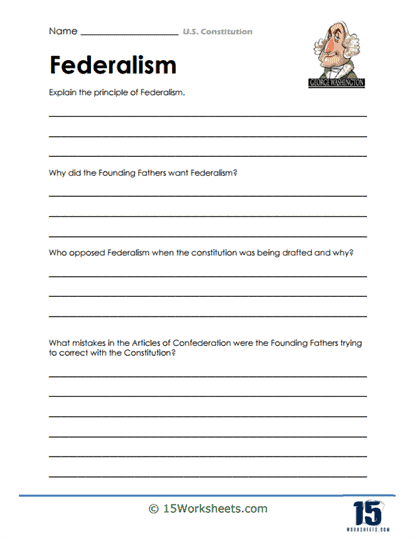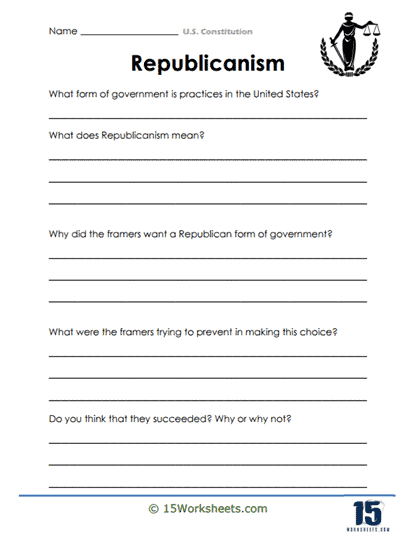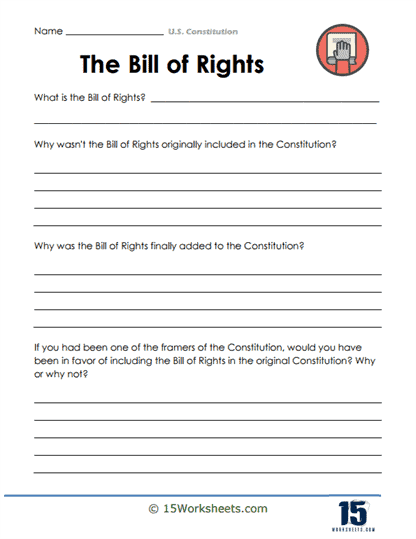U.S. Constitution Worksheets
About These 15 Worksheets
These worksheets were meticulously designed to offer students a deep, meaningful engagement with one of the most pivotal documents in American history: the U.S. Constitution. Their purpose goes far beyond simply providing information; they invite students to truly understand, explore, and critically reflect on the Constitution’s contents and the values it embodies. By breaking down the often complex and archaic language of the original text, these worksheets make the document accessible to learners of all ages and academic levels. Through interactive exercises and thoughtful activities, students are encouraged not just to memorize facts, but to question, analyze, and appreciate the Constitution’s enduring relevance in modern society.
Understanding the Constitution is not merely an academic exercise; it is a gateway to becoming an informed, engaged citizen. The worksheets aim to transform what might seem like a daunting legal text into a living, breathing document that continues to shape the daily lives of Americans. By offering digestible segments and thought-provoking questions, students can connect the historical significance of the Constitution to contemporary issues, making it clear that the ideas it enshrines are not relics of the past, but principles that continue to guide the future of the nation.
The U.S. Constitution, ratified in 1788, stands as the supreme law of the land, a cornerstone of American governance and a blueprint for the country’s democratic ideals. But its importance transcends mere law; it is a reflection of the collective aspirations of the people it serves. The Constitution structures the federal government, delineating powers among the executive, legislative, and judicial branches, thus creating a delicate balance that prevents tyranny and fosters accountability. More than just a manual for governance, however, the Constitution is a safeguard for the rights and freedoms of American citizens. It enshrines principles like liberty, justice, and equality-values that continue to resonate through every debate, every court case, and every piece of legislation.
As a living document, the Constitution has proven both resilient and adaptable, weathering the trials of time, war, social upheaval, and political tension. From the landmark amendments that abolished slavery and granted voting rights to all citizens, regardless of race or gender, to more recent interpretations of civil liberties, the Constitution has grown alongside the nation it serves. It is not a static relic, but a dynamic framework, continuously interpreted and reinterpreted to meet the evolving needs of society.
For students, engaging with the Constitution through these worksheets is more than an educational requirement; it is an opportunity to actively participate in the ongoing story of democracy. They will explore the structure of government, delve into the Bill of Rights, and critically reflect on the amendments that have expanded freedoms and protections over the centuries. By understanding the intricate balance of powers, the checks and balances system, and the rights guaranteed to them as citizens, students are empowered to be not just passive observers, but active participants in the democratic process.
These worksheets encourage students to reflect on the Constitution’s place in today’s world. What does the right to free speech mean in the age of social media? How do the principles of due process and equal protection play out in a modern legal system fraught with challenges of inequality? By asking such questions, students are urged to see the Constitution as more than a historical document, but as a living set of ideals that must be continually upheld and defended.
A Look A The Worksheet Collection
Understanding the U.S. Constitution is a rite of passage for every young American-like learning to tie your shoes, except with more Latin phrases and less bending over. These worksheets kick things off by asking the big question: “Why Was the United States Constitution Created?” It’s not just a historical trivia quiz-it’s a dramatic journey from the floundering Articles of Confederation to a nation with a working brain. Students step into the powdered wigs of the Founding Fathers, navigating grievances, government gaps, and the existential dread of disorganized democracy.
Then comes the showstopper: “The Bill of Rights.” This worksheet reveals how Americans decided, “Hey, maybe we should write down the rights we’re constantly yelling about.” Students debate free speech, religious freedom, and that classic: the right to not have random soldiers sleeping in your house. But it doesn’t stop at the first ten amendments-no sir. There’s a worksheet for “Constitutional Amendments” too, where students trace the wild ride from abolishing slavery to lowering the voting age to 18 (because apparently, if you can be drafted, you can vote).
Of course, we get into the nitty-gritty with “Articles of the U.S. Constitution“-because you can’t appreciate the house without reading the blueprints. Then there’s “The Preamble,” which asks students to decode one of the most over-quoted and least-understood sentences in American history. For visual learners, “Depiction of the Constitution” encourages students to artistically express parchment, quill pens, and abstract concepts like “a more perfect union,” possibly using glitter glue. And if students aren’t already questioning everything, “Controversial Parts of the Constitution” dives into the spicy stuff-like the Three-Fifths Compromise and the Electoral College-because even sacred documents have skeletons in the closet.
Once students know what’s in the Constitution, it’s time for the philosophical deep dive. “Constitutional Principles” (yes, it’s listed twice, so it must be important) tackles the big ideas, like liberty and justice for all, while “Popular Sovereignty” has students reflect on whether “We the People” are actually in charge-or just along for the ride. Through “Limited Government” and “Separation of Powers,” kids see how our forebears basically invented a system that makes sure nobody gets too bossy. Then there’s “Checks and Balances,” which, despite sounding like an accountant’s workbook, is about presidents and Congress politely telling each other “no.”
And who could forget “The Veto“? This one highlights the presidential power to ruin Congress’s party with one signature. Then students explore “Federalism,” where we find out how states and the federal government are in a never-ending tug-of-war that somehow still results in working stoplights. “Republicanism” makes an appearance too-not the political party, but the idea that we elect representatives to, well, represent us. And finally, “Individual Rights” and “Context of The Bill of Rights” ensure that students don’t just memorize freedoms-they understand why they exist, who fought for them, and how they apply to their lives today (like, yes, you do have the right to protest your school lunch).
Types of Exercises on These Worksheets
Article Summaries – Given that the Constitution is divided into Articles, each detailing specific facets of governance, students might be asked to summarize or answer questions about individual Articles. These encourage deeper reflection, asking students to discuss the significance of specific clauses, the impact of particular amendments, or the relevance of the Constitution in modern times.
Amendment Matching – Students can match amendments with their descriptions or effects, ensuring comprehension of the Bill of Rights and subsequent amendments. These exercises assess students’ foundational knowledge, such as understanding checks and balances, the roles of different branches of government, or the rights protected under specific amendments. Students will complete sections of text related to the Constitution, testing recall and comprehension.
Scenario Analysis – Presenting students with real or hypothetical situations, they identify potential constitutional rights or principles in play, promoting application of knowledge. Students will compare the U.S. Constitution to other nations’ constitutions or foundational documents, highlighting similarities and differences.
Primary Source Analysis – Students could analyze historical documents, letters, or Federalist Papers that contributed to or debated the Constitution’s creation. Worksheets will guide students in re-enacting the Constitutional Convention or simulating court cases that challenge constitutional interpretations.

